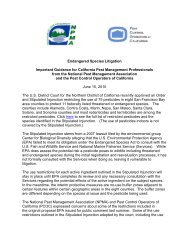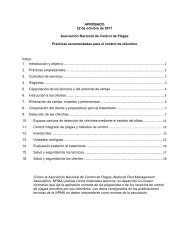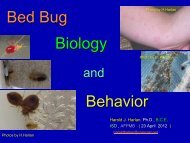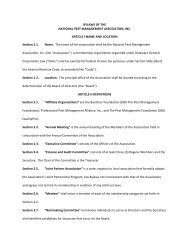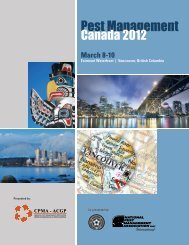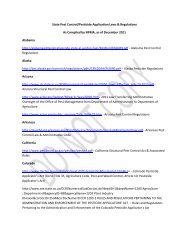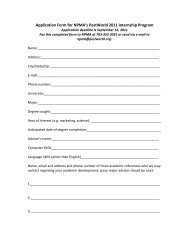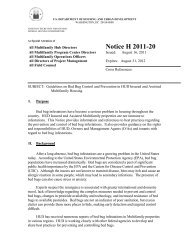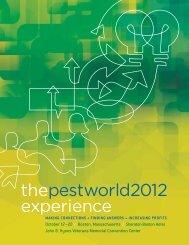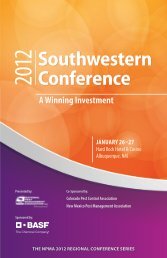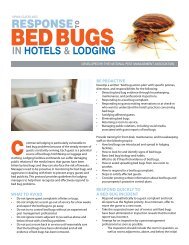Pest Management Standards For Food Plants - National Pest ...
Pest Management Standards For Food Plants - National Pest ...
Pest Management Standards For Food Plants - National Pest ...
You also want an ePaper? Increase the reach of your titles
YUMPU automatically turns print PDFs into web optimized ePapers that Google loves.
Appendix B: <strong>Food</strong> and Drug Administration, HHS § 110.3<br />
to protect food from being contaminated by any source, including unlawful indirect food<br />
additives.<br />
(b) Seams on food-contact surfaces shall be smoothly bonded or maintained so as to<br />
minimize accumulation of food particles, dirt, and organic matter and thus minimize the<br />
opportunity for growth of microorganisms.<br />
(c) Equipment that is in the manufacturing or food-handling area and that does not<br />
come into contact with food shall be so constructed that it can be kept in a clean condition.<br />
<strong>Food</strong> and Drug Administration, HHS § 110.80<br />
(d) Holding, conveying, and manufacturing systems, including gravimetric, pneumatic,<br />
closed, and automated systems, shall be of a design and construction that enables them to<br />
be maintained in an appropriate sanitary condition.<br />
(e) Each freezer and cold storage compartment used to store and hold food capable<br />
of supporting growth of microorganisms shall be fitted with an indicating thermometer,<br />
temperature-measuring device, or temperature-recording device so installed as to show<br />
the temperature accurately within the compartment, and should be fitted with an automatic<br />
control for regulating temperature or with an automatic alarm system to indicate a<br />
significant temperature change in a manual operation.<br />
(f) Instruments and controls used for measuring, regulating, or recording temperatures,<br />
pH, acidity, water activity, or other conditions that control or prevent the growth<br />
of undesirable microorganisms in food shall be accurate and adequately maintained, and<br />
adequate in number for their designated uses.<br />
(g) Compressed air or other gases mechanically introduced into food or used to clean<br />
food-contact surfaces or equipment shall be treated in such a way that food is not contaminated<br />
with unlawful indirect food additives.<br />
Subpart D [Reserved]<br />
Subpart E — Production and Process Controls<br />
§ 110.80 Processes and controls.<br />
All operations in the receiving, inspecting, transporting, segregating, preparing, manufacturing,<br />
packaging, and storing of food shall be conducted in accordance with adequate<br />
sanitation principles. Appropriate quality control operations shall be employed to ensure<br />
that food is suitable for human consumption and that food-packaging materials are safe<br />
and suitable. Overall sanitation of the plant shall be under the supervision of one or more<br />
competent individuals assigned responsibility for this function. All reasonable precautions<br />
shall be taken to ensure that production procedures do not contribute contamination<br />
from any source. Chemical, microbial, or extraneous-material testing procedures shall be<br />
used where necessary to identify sanitation failures or possible food contamination. All<br />
food that has become contaminated to the extent that it is adulterated within the meaning<br />
of the act shall be rejected, or if permissible, treated or processed to eliminate the<br />
contamination.<br />
(a) Raw materials and other ingredients. (1) Raw materials and other ingredients shall<br />
be inspected and segregated or otherwise handled as necessary to ascertain that they are<br />
clean and suitable for processing into food and shall be stored under conditions that will<br />
protect against contamination and minimize deterioration. Raw materials shall be washed<br />
or cleaned as necessary to remove soil or other contamination. Water used for washing,<br />
rinsing, or conveying food shall be safe and of adequate sanitary quality. Water may be<br />
reused for washing, rinsing, or conveying food if it does not increase the level of contamination<br />
of the food. Containers and carriers of raw materials should be inspected on<br />
receipt to ensure that their condition has not contributed to the contamination or deterioration<br />
of food.<br />
(2) Raw materials and other ingredients shall either not contain levels of microorganisms<br />
that may produce food poisoning or other disease in humans, or they shall be<br />
pasteurized or otherwise treated during manufacturing operations so that they no longer<br />
contain levels that would cause the product to be adulterated within the meaning of the<br />
act. Compliance with this requirement may be verified by any effective means, including<br />
B<br />
APPENDIX<br />
33



